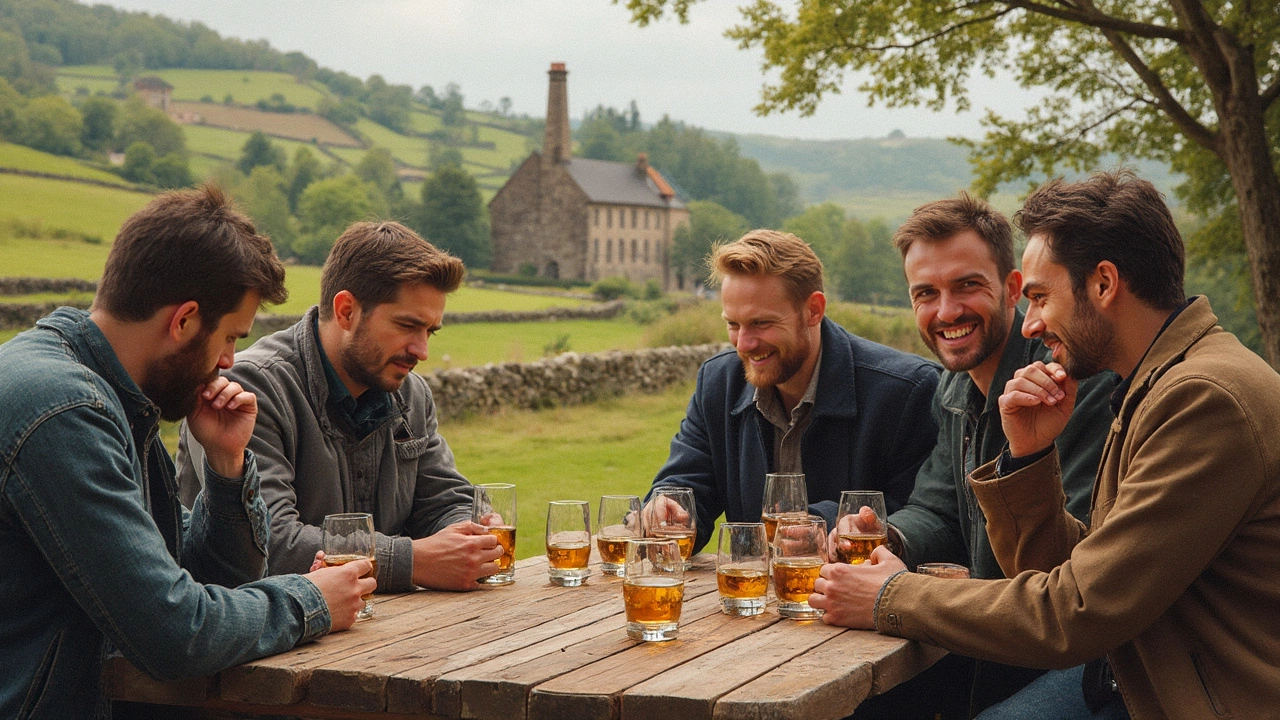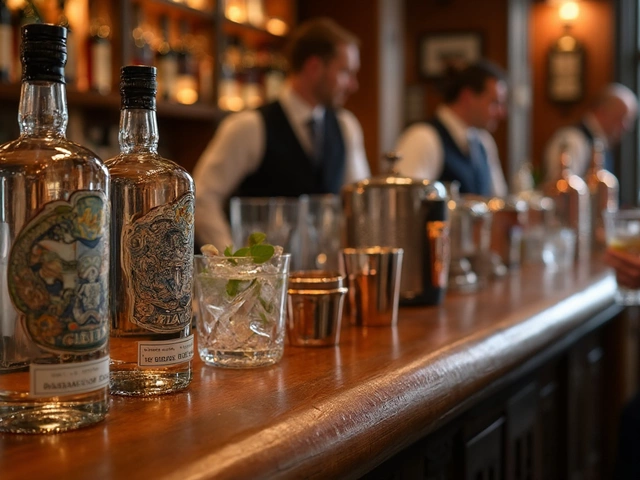Ever heard of a 'whiskey nose'? Surprisingly, it's not about waking up with a scent of last night's fun. A whiskey nose is all about honing your sense of smell to better enjoy your whiskey experience. Think of it as channeling your inner detective, picking up on clues with your nose before you take that first sip.
Turning your focus to aroma isn't about being fancy; it's practical. You see, whiskey is packed with different scents that give you a sneak peek into its flavors. From fruits and spices to earthy, smoky notes, these aromas tell a story even before the liquid touches your taste buds.
Getting better at nosing doesn't mean having a super nose. It involves practice, kind of like learning a new hobby. You can start small, with simple techniques to help pick out scents you didn't even know were there. So, grab a glass, take a deep breath, and let’s dive into the world of whiskey aromas.
- Definition of Whiskey Nose
- The Science Behind Aromas
- Common Scents in Whiskey
- How to Develop Your Nose
- Whiskey Nosing Tips and Tricks
- Enhancing the Tasting Experience
Definition of Whiskey Nose
So, what exactly is a whiskey nose? It's not just some fancy term for enthusiasts; it's the whole experience of evaluating whisky through its aromas before you even take a sip. Essentially, your nose is doing the hard work your tongue typically handles, but with much more finesse.
The process of 'nosing' involves swirling your glass gently to release the whisky's complex vapors. You're looking to detect those lovely scents—often referred to as 'notes'—that give you insight into its flavor profile. These could range from floral and fruity to spicy and peaty aromas, providing a preview of the taste without any alcohol physically touching your taste buds.
Why is it Significant?
The art of having a well-tuned whiskey nose can elevate your tasting game significantly. Think of it as getting a backstage pass to a show, where you can appreciate the subtleties and craftsmanship involved in whisky production. Being able to identify specific aromas in whisky isn't just about showing off; it helps you understand and enjoy the character of different whiskies way better.
Key Factors Affecting Whiskey Nose
Several elements play a part here. First up is the material of your glass. Tulip-shaped glasses are often recommended because they concentrate aromas, making it easier to sniff out those hidden notes. Temperature also matters; a cooler whisky might not release as many aromas as one that's slightly warmed. Lastly, everyone's sense of smell is unique, and fluctuations can happen based on your environment or even your current health.
In the world of whisky tasting, developing a robust whiskey nose is a journey of discovery, opening up new layers and depths within each bottle. So next time you pour yourself a dram, take a moment to appreciate what your nose can tell you—it might just surprise you!
The Science Behind Aromas
Ever wondered what makes your whiskey smell so distinct? It all boils down to the science of aromas. This involves how molecules evaporate and interact with our senses. When you pour whiskey into a glass, the liquid releases volatile compounds into the air. These compounds are what tickle your nose and hint at what you’re about to taste.
Our sense of smell, or olfaction, is connected to the limbic system in the brain, which is tied to emotions and memories. This is why that first whiff of whiskey can transport you back to memories or evoke specific feelings. According to Dr. Charles Spence, a professor in experimental psychology, "The experience of smell greatly affects our perception of taste, making it a fundamental part of how we enjoy food and drink."
How Aromas Develop
The aromas in whiskey develop during various stages of production. Here's a breakdown:
- Fermentation: This is where yeast interacts with natural sugars from the grains, creating fruity and floral aromas.
- Distillation: Higher temperatures can create esters, which are responsible for sweet, fruity smells.
- Barrel Aging: As whiskey rests in barrels, it absorbs compounds from the wood, leading to vanillin and tannins, which add notes of vanilla, caramel, and spice.
The Role of Water
Adding a splash of water to your glass isn't just for dilution. It also changes the surface tension, allowing more aroma molecules to be released. This is why some experts suggest dropping a bit of water into your whiskey to enhance smell and flavor.
Understanding these basics can transform how you approach your next tasting session. Recognizing the molecular dance that creates each scent opens up a deeper appreciation of what makes whiskey so enjoyable.
Common Scents in Whiskey
Let’s dig into what you might sniff when you’re nosing your whiskey. Whiskey lovers aren't just imagining those fruit or smoke aromas. These are real scents arising from ingredients, production, and aging processes.
Fruity Aromas
Fruits often come forward in whiskies, ranging from apples and pears in younger whiskies to rich, dried fruits like raisins and figs in older ones. These scents usually derive from the fermentation process and often the barrels, especially sherry ones, add that fruity punch.
Spicy and Sweet Notes
Ever get a whiff of vanilla, cinnamon, or nutmeg? That's the wood talking. The barrels, typically made of charred oak, add these deliciously inviting spicy and sweet notes. You’ll often find bourbon full of these softer aromas due to its new charred oak aging.
Smoky and Peaty Whiffs
Now, the smoky, earthy tones are a big marker in Scotch, especially those from Islay. The peat used during the malting process gives off those smoky aromas. It's like a campfire in a bottle. Not everyone’s cup of tea, but it’s definitely distinct.
Floral and Herbal Undertones
Sometimes you catch hints of flowers or fresh herbs. These lighter notes often pop up in Irish whiskies or those from regions using less peat. Think of a summer meadow, refreshing and uplifting.
Table of Common Whiskey Aromas
Check out this handy table to navigate through the scents:
| Aroma Type | Common Whiskey |
|---|---|
| Fruity | Apple, Pear, Raisin |
| Spicy | Vanilla, Cinnamon |
| Smoky | Earthy, Peaty |
| Floral | Light, Herbal |
Keep practicing and soon, you'll be picking up these common scents like a pro during whisky tasting sessions. It’s all about training your senses and, of course, enjoying the journey.

How to Develop Your Nose
Enhancing your whiskey nose isn't magic—it's practice. You don’t need to be born with a super sniffer, just a willingness to explore and learn. First, start by exploring the different aromas in your everyday life. The goal is to train your brain to recognize and remember different scents.
Start with the Basics
Grab some common household items like coffee beans, vanilla, citrus fruits, and spices like cinnamon. Try smelling each one individually. Notice how each scent feels—sharp, sweet, spicy? These are similar aromas you'll find in whiskeys, so getting used to them is a great first step.
Use the Right Glass
A tulip-shaped glass or a Glencairn glass helps concentrate the aromas towards your nose, making it easier to pick up different notes. Pour a small amount of whiskey and give the glass a gentle swirl. This releases more aromas.
Practice the Smelling Technique
- Take a quick, light sniff first to avoid overwhelming your senses.
- Breathe in through your nose, savoring the range of aromas.
- Take a break and then take several short sniffs.
These steps help you catch the more subtle notes without fatigue.
Consistency is Key
Regular practice is your best friend here. Over time, you'll start noticing patterns and differences in aromas across different whiskeys.
Nose with intention. Focus on identifying distinct aromas each time you try a new whiskey. Is it fruity, floral, smoky? With patience, you'll become more adept at recognizing and appreciating these varied scents.
Track Your Progress
Keep notes of what you smell with each whiskey. Creating your own aroma library helps you become more familiar with different profiles and compare them over time.
Whiskey nosing is like learning a new language. It might seem complicated at first, but with practice, it becomes second nature.
Whiskey Nosing Tips and Tricks
Diving into whiskey nosing can be super fun and rewarding. But where do you start if you want to really tune into that whiskey nose? Let’s break down some practical steps to help you sniff like a pro.
1. The Right Glassware Matters
Using the right glass can make a big difference. A tulip-shaped glass is perfect. Its narrow opening focuses the aromas, making them easier to detect. So, if you don’t have one yet, maybe consider picking one up.
2. Start with the Basics
Before you jump into complex scents, identify the basic ones. Think vanilla, citrus, caramel, or smoke. These are common and often easy to pick up. Establishing these basics can build your nosing confidence.
3. Give it a Swirl... But Not Too Much!
A gentle swirl helps open up the whiskey. It releases the aroma compounds stuck in the glass. But don’t go wild; too much can sometimes overpower delicate notes with alcohol vapors.
4. Control Your Sniffs
Get close to the glass but not too close that you overwhelm your senses. Take quick gentle sniffs instead of a deep inhale. This helps you catch the nuances without numbing your nose.
5. Take Your Time
Whiskey nosing isn’t a race. Give it a minute to reveal more layers. Just like a good story, a whiskey needs some time to unfold completely.
6. Practice Often
The more you practice, the better you'll get. Try new whiskeys and revisit the ones you know. Keep at it, and you might surprise yourself with just how nuanced your nose becomes!
Remember, developing a strong whiskey nose takes practice and patience. But with these tips and tricks in hand, you're on your way to enjoying whiskey to the fullest. Happy nosing!
Enhancing the Tasting Experience
You've picked up a whiskey nose, and that's cool. But there's more to sipping than just sniffing. Let's talk about turning that nosing skill into a full-blown whisky tasting experience to savor.
Start with the Right Glass
First things first, not all glasses are created equal. You want to use a Glencairn glass or something with a tulip shape. Why? It traps the aroma, channeling it right into your nose. That helps highlight all those hidden aromas before taking a sip.
Temperature Matters
Temperature can mess with the taste big time. Room temp is best because chilling can dull the flavors, while heating up too much can make the alcohol overpowering. So, let it settle in the glass for a bit.
Pace Yourself
This isn't a race. Sipping whisky is about slowing down and truly experiencing it. Start with a gentle swirl of the glass. That lets oxygen mix with the liquid and brings out more scents and flavors.
- Swirl it lightly—this activates the aromas.
- Take it slow—sip gently and let the liquid coat your palate.
- Savor it—notice how the flavors evolve while it's in your mouth.
Take Notes
Keep a little notebook handy. Writing down what you sense—specific flavors or unfamiliar scents—can help you develop a better nose for the future. Look for hints of vanilla, citrus, spices, or even chocolate and tobacco. You'll start to pick out specific profiles faster.
Water Can Be a Friend
Despite what purists say, a drop of water might unlock surprisingly fruity or spicy notes hidden within the whiskey. Add a drop, watch it open up, and take another sniff. You'll likely get a new layer of aromas you hadn't noticed before.
Remember, whiskey tasting isn't just an activity—it's a journey. A little patience and practice, and you can transform a casual glass into a deep, flavorful experience.


